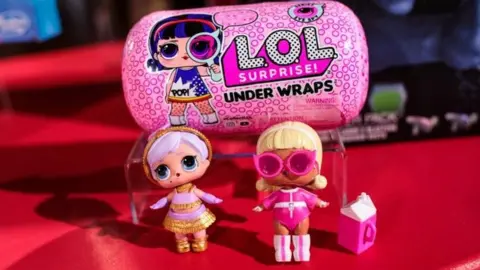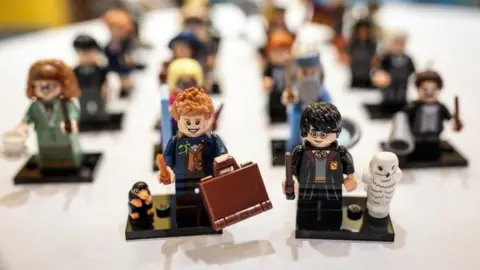Parents spending heavily on mystery toys
 Getty Images
Getty ImagesParents are spending heavily on mystery toys as a craze in wrapped-up collectables is set to dominate Christmas sales.
Sales of collectable toys - such as the L.O.L. range - have risen by 30% in the year so far, compared with the same period of 2017.
They now account for three in 10 of toys sold, analysts say.
The sector is banking, in part, on their success after a difficult year following the collapse of Toys R Us.
The British toy market has dipped by 5% in the first nine months of the year, compared with the 2017 equivalent, according to sector analysts NPD.
Spending on Christmas toys totals £110 per child up to the age of 11, down from £121 a year ago.
"This year has been more challenging than any other in my 20 years of studying the industry," said NPD's global analyst, Frederique Tutt.
Toys R Us, which held about 10% of the UK toy market, collapsed early in the year. In March, it was announced that all 100 UK stores would close their doors, with the loss of 3,000 jobs.
The pre-closure discounts and then the retailer's disappearance had hit the sector's bottom line, Ms Tutt said. The only comparable "game changer" in recent years was the loss of Woolworths on the High Street, she said.

Analysis of the British toy industry
 Getty Images
Getty Images- Children aged up to 11 typically receive 10 toys at Christmas
- More than half (59%) of toy spending for Christmas was on gifts chosen by the giver, rather than from children's wishlists, compared with 39% in Europe
- Christmas sales account for 34% of annual spending on toys and total £1.2bn
- Some 61% of toy sales were made in stores
- About 40% of a typical child's toy collection is renewed every year
Source: NPD Group

Gary Grant, chairman of the Toy Retailers' Association Dream Toys selection committee - which has chosen its top 12 toys for Christmas - said that the remaining retailers had done relatively well after the Toys R Us collapse.
He said that the toy industry bucked the trend of the High Street, with new stores being opened. Parents, grandparents and children were drawn to toy shops to see and try products, rather than "looking at a picture of the box" on the internet, he said.
He said the industry was hoping for a rebound in 2019 on the back of some major film releases, such as the Lego and Toy Story movies. Franchised toys have traditionally done well following their previous films.
However, the current craze has been ranges such as L.O.L. Surprise - the biggest seller of the year so far.
Inspired by "unboxing" videos on sites such as You Tube, the product comes with layers of wrapping before the child reaches the mystery toy inside. There are various toys to collect.
Their popularity may be exasperating for parents who, like the children, have no idea which wrapped-up character they have bought.
Launched in April last year by privately-owned MGA Entertainment, the creators of the Bratz dolls, with no TV advertising, the level of success of L.O.L. was a surprise to the company itself, according to its managing director in the UK, Andrew Laughton.
He said the toy built on the tradition of pass-the-parcel games, but the latest versions hit all the trends in toys, ranging from slime to unicorns.
The range of prices has grown too, with the most simple collectables costing £3.99, but the most elaborate costing £179.99.
Ms Tutt said parents might be tempted to look at videos of these products on social media as well, to find out exactly what they are getting for their money.
